Scottish hydrogen: assessment report
Examines how applications of hydrogen-based technologies in transport, industry, heat and whole system approaches can best be deployed in Scotland.
7 Economic Assessment
7.1 Overview and purpose
Realising Scotland's 2045 vision for net-zero will require a transformation of the energy system, providing opportunities for Scottish based companies to generate employment and value for Scotland in the process. The hydrogen sector consists of a complex set of value chains which could either replace existing energy activities or create new avenues for value and job creation. This economic impact assessment (EIA) aims to quantify the socio-economic benefits that could arise from each of the three scenarios explored in the previous section and provide insights into the opportunities they might provide for wealth and job creation.
While the global market for hydrogen technologies remains small, it is growing rapidly and is expected to figure prominently in the future global energy picture. Figure 39 shows the potential areas of value from the hydrogen sector would in Scotland.
Scotland's ability to capture this value will be dependent on whether it already possesses the required skills or whether it can attract and retain these in the future.
Both quantitative outputs and qualitative commentary are provided on the possible economic value created within the sectors that are assumed to convert wholly or partially to the use of hydrogen. These are considered under the three scenarios and in three analysis years - 2025, 2032 and 2045.

GVA estimation approach
The approach taken to this EIA consists of two stages: firstly, to estimate the total GVA associated with the hydrogen related activities in each scenario, and secondly to identify how much of that value could be captured in Scotland. The model approach design and key conceptual design aspects are set out in further detail in Appendix A4.2.
The assessment of the value creation potential of activities within the hydrogen sector uses an economic value-added approach. The GVA equates to the sum of compensation of labour, return on capital i.e. annualised CapEx and margin i.e. gross profits. GVA is estimated for each of the hydrogen activities that the scenarios deploy using a bottom-up approach.
For many activities, such as hydrogen vehicles, activity in Scotland will be limited to the sale, installation, operation and maintenance of equipment produced elsewhere, so less detailed cost breakdowns are required in these cases. In these instances, GVA relates to the utilisation of assets and margin of companies operating them as well as the margin for companies installing these assets and the labour they employ.
The analysis is subject to a number of limitations which are highlighted below. More detail can be found in Appendix A4.1.
- The model is neither a full or partial economic equilibrium model;
- The analysis does not represent a full energy system model and only hydrogen related activities are considered; and
- Additionality is only considered from a qualitative perspective since it cannot be quantified without considering the whole system.
7.2 Key findings
The EIA estimates the value added that could generate to Scotland under each of the three scenarios. This includes both a quantitative analysis as well as a qualitative assessment. The qualitative assessment includes the capacity of each scenario to deliver regional development, fit with Scottish skills base, extent of use of existing assets and infrastructure, as well as technical and non-technical barriers to the successful delivery of scenarios. In the following sections we provide summary data but a full set of Figure tables is provided in Appendix A4.4.
The big picture
In 2045 the GVA contribution is expected to be highest in Green Export in which roughly £26 bn of value is generated. The considerable activity associated with large scale roll-out of green hydrogen production contributes significant added-value and export potential (see Figure 40). Green Export also delivers the most employment with more than 300,000 jobs either retained or created (see Figure 41).
By contrast, in Hydrogen Economy the more widespread use of hydrogen domestically such as in heat and transport ensures that this scenario also makes a significant contribution in terms of GVA generating £16 bn and 177,000 jobs created. The broader use of hydrogen domestically ensures that value-added and jobs are more evenly distributed across sectors in Hydrogen Economy relative to Scenario B.
While Focused Hydrogen has lower overall amounts of hydrogen produced and used with hydrogen generating GVA of £5.7 bn and 69,000 jobs, it has the potential to deliver localised value in regions and more even distribution of activities.
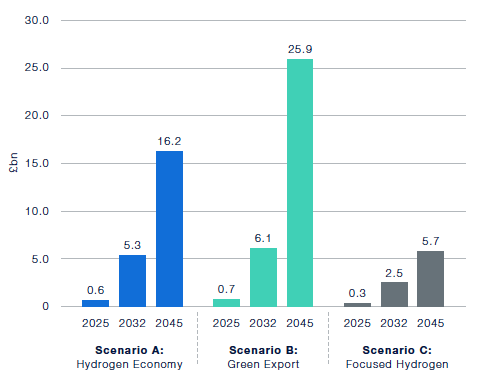
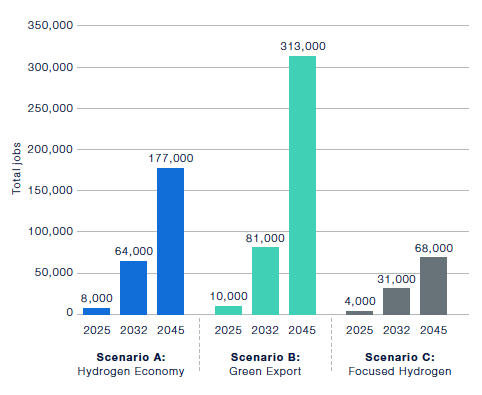
Sector contributions to GVA vary according to the features of the scenarios as shown in Figure 42 and Figure 43.
To put these figures into context:
- Total GVA attributable to the O&G sector is estimated at £16 bn[73] while the electricity and gas supply sector represented around £6 bn GVA[74].
- Transport, storage and communication GVA is around £12bn[74].
- The estimated combined employment in the O&G and low carbon energy sectors is nearly 125,000[73].
This is further illustrated in Table 7, which provides a heatmap of the relative contributions to value and jobs by activity in each scenario. Whereas in Hydrogen Economy and Green Export, the most important contributor of value is hydrogen production, the contributions are more balanced across sectors in Focused Hydrogen.
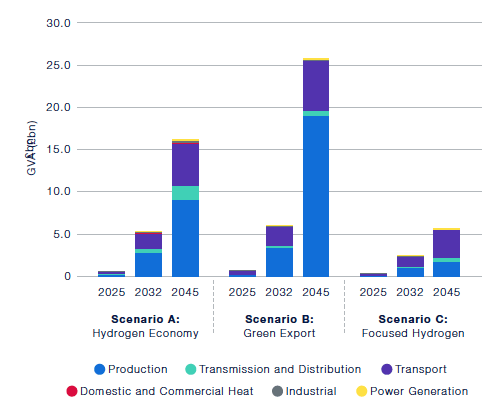
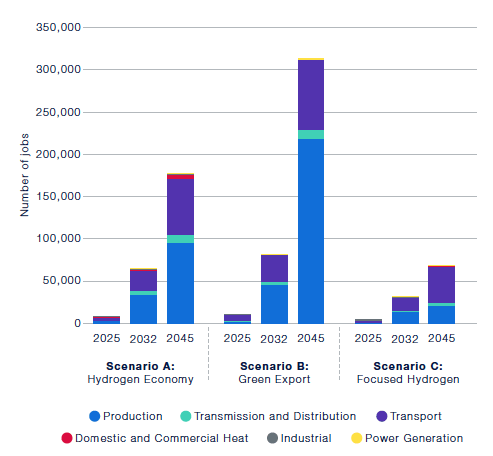
| Scenario A | Scenario B | Scenario C | ||||
|---|---|---|---|---|---|---|
| GVA | Jobs | GVA | Jobs | GVA | Jobs | |
| Production | ||||||
| Onshore Green | ||||||
| Deployment | 0.4% | 0.8% | 0.2% | 0.3% | 2.1% | 3.9% |
| Operation | 5.1% | 5.9% | 4.4% | 4.6% | 22% | 22% |
| Offshore Green | ||||||
| Deployment | 5.2% | 11% | 10% | 19% | ||
| Operation | 31% | 26% | 59% | 46% | ||
| Blue | ||||||
| Deployment | 2.6% | 5.5% | 1.2% | 2.2% | ||
| Operation | 13% | 4.6% | 6.2% | 2.0% | ||
| Transmission and Distribution | ||||||
| Transmission | ||||||
| Operation | 1.7% | 0.3% | 0.5% | 0.1% | 1.5% | 0.2% |
| Distribution | ||||||
| Operation | 6.1% | 3.3% | 0.0% | 0.0% | 4.8% | 2.3% |
| HRS | ||||||
| Deployment | 0.6% | 1.0% | 0.8% | 1.2% | 1.2% | 1.6% |
| Operation | 0.5% | 1.1% | 1.1% | 2.3% | 0.8% | 1.6% |
| Transport | ||||||
| Buses | ||||||
| Manufacturing | 0.3% | 0.3% | 0.2% | 0.2% | 0.4% | 0.4% |
| Transport services | 8.3% | 11% | 5.7% | 6.8% | 9.3% | 11% |
| HGV | ||||||
| Transport services | 18% | 21% | 11% | 12% | 39% | 40% |
| Passenger cars and LGVs | ||||||
| Retail and maintenance | 1.1% | 1.9% | 3.3% | 5.5% | 1.5% | 2.4% |
| Trains | ||||||
| Transport services | 2.0% | 2.4% | 1.3% | 1.4% | 5.8% | 6.3% |
| Water transport | ||||||
| Transport services | 2.1% | 1.4% | 1.3% | 0.8% | 3.1% | 1.8% |
| Domestic and commercial Heat | ||||||
| Operation | 1.1% | 2.2% | 0.0% | 0.0% | 0.6% | 1.1% |
| Industry and Power Generation | ||||||
| Industrial heat and feedstock | ||||||
| Maintenance | 0.9% | 0.8% | 0.3% | 0.2% | 0.8% | 0.6% |
Figure 44 indicates locations around Scotland where value creating activities will likely be undertaken; these vary somewhat according to the scenario being considered. Broadly speaking, specialist manufacturing is likely to be focused in the central belt, the industry sector in Fife and Stirlingshire, and the offshore deployment and support in Aberdeenshire/City of Aberdeen. By contrast, non-specialist manufacturing and transport and heat provision would be relatively more evenly distributed across Scotland.
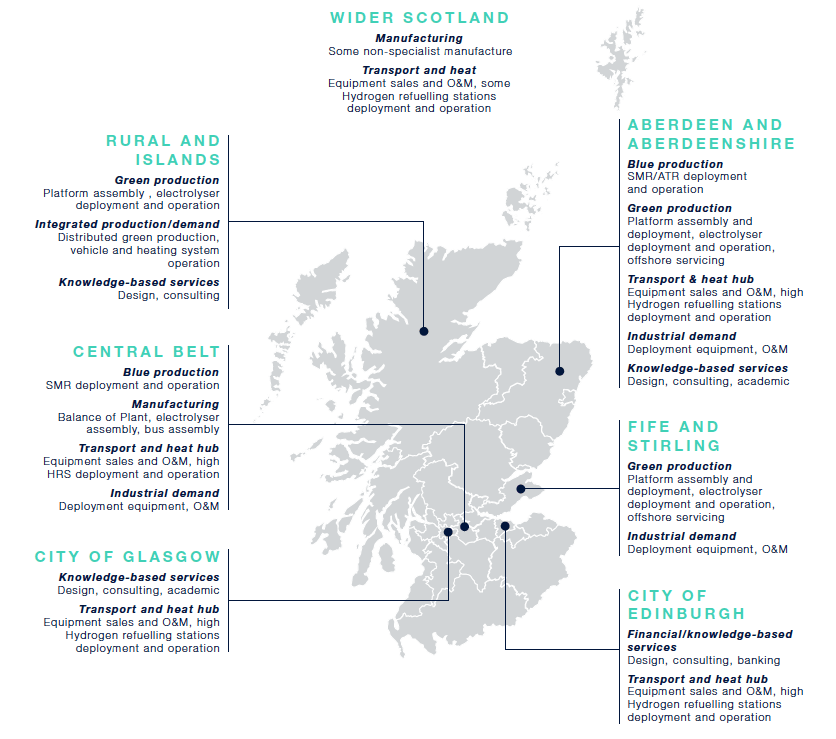
Production: The Future Engine of the Hydrogen Economy in Scotland
Hydrogen production is the biggest absolute contributor of value with the potential to generate nearly £20bn of GVA and employ over 200,000 people in 2045 in Green Export. By this date, offshore hydrogen production is by far the biggest contributor of value in both Hydrogen Economy and Green Export, reflecting the rapid rollout of capacity and the relatively high value added per unit of output.
The total number of jobs created varies from around 20,000 in Focused Hydrogen to over 200,000 in Green Export in 2045. Jobs are split between construction (28% in Hydrogen Economy) and operation (72%) with a tail off in construction jobs expected after 2045 as the build out rate falls. However, in order to meet the necessary build out rates construction is expected to continue right up to 2045, see Figure 45. It is expected that skilled technician and engineer roles to feature highly, reflecting the complex nature of the activities.
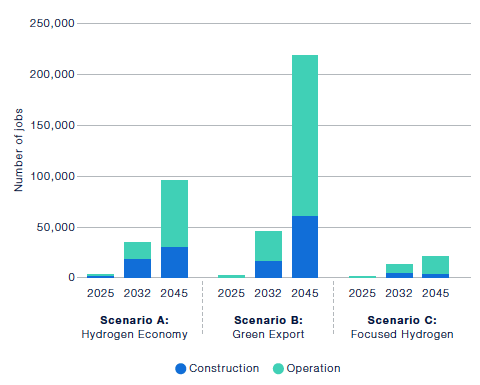
| Sub-sector | Source of Value | Additionality | Skills & Location |
|---|---|---|---|
| Onshore green production Jobs in 2045 A: 9.600 B: 1,000* C: 4000 * Note that this figure is low owing to slow down in onshore construction rates by 2045. |
Manufacturing Some manufacture of installation materials. Possible electrolyser system integration in Hydrogen Economy and Green Export. Deployment Electrolyser & onshore wind turbine installation. Maintenance Electrolyser and wind farm maintenance. Hydrogen production Generation and sale of green hydrogen. |
Majority of these activities are new* especially in the case of green hydrogen for export. * Note that this may in part replace O&G activities that currently meet the equivalent energy demand. |
Significant skills in deployment of bulk onshore wind power. Manufacturing mostly in the central belt. Operation and maintenance could be quite distributed. |
| Offshore green production Jobs in 2045 A: 65,700 B: 202,900 |
Manufacturing Some manufacture of installation materials. Possible electrolyser system integration. Deployment Electrolyser and offshore wind turbine installation. Maintenance Electrolyser and wind farm maintenance. Hydrogen production Generation and sale of green hydrogen including export. |
Majority of these activities are new although note that this may in part replace O&G activities that currently meet the equivalent energy demand. | Significant skills in deployment of offshore renewables. Construction, deployment and servicing centred around existing shipyards and offshore O&G locations, e.g. Aberdeen. Manufacturing mostly in the Central Belt which may also be the logical location for potential electrolysis integration plant. Additional port activity associated with services and potentially export of hydrogen. |
| Blue production Jobs in 2045 A: 18,000 C: 3,000 |
Manufacturing Some manufacture of installation materials. Deployment Installation of SMR/ ATR plant plus CCUS facilities. Maintenance SMR/ATR plant maintenance. Hydrogen production Generation and sale of blue hydrogen. |
Majority of these activities are completely new although note that this may in part replace O&G activities that currently meet the equivalent energy demand. | Coincides with existing O&G and petrochemical, e.g. Grangemouth and St Fergus. Offshore servicing capability also relevant for CCUS in depleted oil & gas reservoirs. |
Scotland has a natural advantage in green hydrogen production but there are gaps in the supply chain.
The green hydrogen supply chain includes both small scale and large scale production requirements and similar supply chain structures apply to both onshore and offshore scenarios. The supply chain elements required to manufacture green hydrogen using electrolysis, including renewable electricity supply, is relatively well supported in Scotland. Scotland has good system integration skills and considerable offshore expertise from the O&G sector which could be leveraged for the green hydrogen supply chains. It has a range of fabricators and non-specialist component manufacturers that could effectively compete for non-hydrogen specific supply chain elements. It also possesses a wide range of engineering design and academic research capabilities that could be brought to bear.
By contrast, Scotland has limited expertise in the manufacture of key system elements including electrolysers and wind turbines. These would be high value added activities as would be the specialist extended supply chains that go with them. Scotland could benefit from attracting an existing or new electrolyser producer to locate an assembly plant in the region and this would not only generate direct jobs and value but may also lead to the establishment of a local supply chain to service that plant. The value of electrolyser assembly has been estimated in Green Export to reach £1.5 bn in 2045, creating over 3,500 jobs. However, the value attributable to the wider supply chain could increase this further if manufacturing component elements, could also be established locally.
Scotland has a natural advantage in green hydrogen production given the huge potential offshore and onshore resource and for this reason, attracting local electrolyser or wind turbine assembly plant to Scotland is a credible goal.
However, supply chain competition will be fierce and electrolyser firms may seek to centralise activities in order to benefit from scale economies. In order to fully capitalise on the opportunity from green hydrogen production consideration should be given to how best to nurture these core activities. This may require supportive policies and will be subject to the establishment of an adequate supply chain, whether locally or extended.
The sheer scale of investment required to realise the green production potential in Hydrogen Economy and Green Export presents challenges in terms of mobilising capital and resources and the effort required should not be underestimated. Access to capital could present a major hurdle to the achievement of these scenarios.
Key skills and supply chain present in Scotland
While Scotland has a limited indigenous manufacturing supply chain for provision of key plant like wind turbines, it has some key existing and transferrable skills from its renewable and energy sectors including:- A strong existing renewables sector with many onshore and offshore wind developers with locations and active projects within Scotland. The supply chain capabilities are centered around development, construction including civil and electrical contractors, and operations.
- As electrolysis projects have developed in Scotland organisations are building up capabilities to support the development of these projects. EMEC first procured a hydrogen electrolyser in 2015 and have since gone on to expand their portfolio of hydrogen projects.
- A number of Small to Medium Enterprises (SMEs) in Scotland specialise in areas of the electrolyser supply chain. Examples include: Pure Energy Centre, an electrolyser integrator or assembler located in Shetland and; Logan Energy a system integrator and operator based in Edinburgh.
- Scotland’s O&G sector has transferrable skills in the supply and service of process engineering kit.
Scotland may be able to leverage its flagship CCUS project to develop know how in blue hydrogen
Many of the supply chain elements required for the production of blue hydrogen from methane via steam methane reforming (SMR) or auto thermal reforming (ATR) exist already in Scotland's O&G industry. The same is also largely true for CCUS. SMR/ATR plants are typically bespoke and built at the installation site, with many of the components, e.g. pressure vessels, pipework and supporting steelwork, being relatively standard items which could be manufactured in Scotland.
There is limited potential for the development of core intellectual property (IP) around SMR/ATR and CCUS although the integration of these two elements for blue hydrogen production may offer opportunities. These are high value added activities but at present much of this IP is being captured outside Scotland by the large industrial companies and engineering, procurement and construction vendors. As with green hydrogen production, the natural advantage offered by Scotland in terms of access to natural gas supply and carbon storage potential opens the door to local firms being able to capture more of the value chain. The extent to which Scotland is able to generate IP in this area will also determine the extent to which this sector could offer export potential in the same way that Scotland exports O&G expertise recognising that there are strong incumbent players.
Further value-added opportunities may exist in liquid fuels production
The analysis assumes that hydrogen is used and exported in gaseous or liquid form but in practice hydrogen may be transported and ultimately used as ammonia, methanol or any number of synthetic hydrocarbons from methane to jet fuel. If these fuels and energy carriers become established, then they are generally most economically co-produced in the same location as hydrogen. Scotland may therefore be in a position to add further value to the hydrogen being produced by synthesising these fuels and chemicals. The skills assessment points to the presence of relevant skills in Scotland which could be exploited to realise this additional economic opportunity.
Key skills and supply chain present in Scotland
The skills associated with blue hydrogen production commonalities with both the construction and operation of thermal and gas processing plants, and to offshore exploration and production (E&P) activity. Scotland does not have indigenous suppliers of the main plant and equipment, and a significant proportion of the O&G supply offshore vessels are international. However, the significant indigenous supply chain could support in a range of areas, including:
- A number of services companies and contractors supporting E&P have the skills to design construct and operate the pipelines, platforms and wells associated with CCUS infrastructure.
- The skill set from Scotland’s onshore O&G processing terminals such as INEOS at Grangemouth and the various facilities at St Fergus, alongside historical expertise in thermal plant operation from utilities such as SSE, and the civil and process contractors that support them will translate into onshore hydrogen production
- Several O&G operators including SGN and National Grid are participating in both the Acorn Hydrogen and Acorn CCUS projects being developed by Pale Blue Dot Energy at St Fergus.
Transmission and distribution: Building on solid foundations
In Hydrogen Economy where the existing network is maintained, the GVA contribution from the transmission and distribution sector is modest at roughly £1.5 bn in 2045, while sector jobs could be significant reaching nearly 10,000. As discussed in Table 9, these jobs will be largely retentive of existing economic activity in the transmission and distribution of natural gas and will be relatively distributed across the country.
| Sub-sector | Source of Value | Additionality | Skills & Location |
|---|---|---|---|
| Transmission Jobs in 2045 A: 400 B: 200 C: 100 |
Maintenance Maintaining the transmission network. Hydrogen transmission Transport and sale of hydrogen to the distribution grid and large end-users. |
Hydrogen would result in the continued operation of the existing gas network which would lead to job and value retention which otherwise would be lost as the grid is decommissioned. | The network is widely distributed but most of the O&M economic activity will be centred on existing facilities, e.g. SGN head office in Edinburgh. Emerging skills in storage. |
| Distribution Jobs in 2045 A: 5,900 C: 1,600 |
Maintenance Maintaining the full distribution network in Hydrogen Economy and reduced network in Focused Hydrogen. Hydrogen distribution Delivery and sale of hydrogen to end-users. |
O&M of the existing network would lead to job and value retention. | While the network is widely distributed most of the O&M economic activity will be centred around existing facilities, e.g. SGN head office in Edinburgh. Emerging skills in storage. |
| Hydrogen refuelling Jobs in 2045 A: 3,700 B: 11,000 C: 2,200 |
Deployment Installation of hydrogen refuelling stations. Maintenance Maintaining hydrogen refuelling stations. Forecourt services Sale of hydrogen to hydrogen refuelling stations customers. |
Installation could be considered additional while hydrogen refuelling stations operation is likely to be replacement or retentive. | Fairly distributed activity reflecting the location of stations; more concentrated in centres of population and highly regionalised in Focused Hydrogen. |
Scotland has a good range of skills in transmission and distribution
Scotland possesses a good range of skills in the field of pressurised gas transmission and distribution and this is supplemented with capabilities in petrochemicals and O&G. The use of hydrogen in the gas network will be explored in the H100 project, a world first for the supply of 100% hydrogen to a cluster of homes in the Fife region, and this might allow the development of specific IP. Scotland has developed emerging skills in hydrogen storage which will be required to act as a buffer to account for short and long term variations in production and end use and could take the form of both pressure or cryogenic vessels and geological stores such as porous rock or salt caverns.
Much of the value associated with the use of hydrogen as an alternative to natural gas in the gas network could be captured by Scottish firms. An opportunity to capture additional value and jobs in the deployment of new transmission or distribution grid infrastructure also exists, particularly in Green Export. However, since the geographic detail needed to evaluate this is beyond the scope of the current study, this has not been included.
Scotland has limited skills in hydrogen refuelling stations technology development
Scotland has some existing capabilities in the operation of hydrogen refuelling sites, such as the ones in Aberdeen to service the bus fleet. However, to date the sites have been built and maintained by non-Scottish entities. Much of the value associated with the deployment and operation of hydrogen refuelling infrastructure could be captured in Scotland although this may not be very high value added if the core IP is owned outside Scotland. Efforts to localise the design and manufacture of elements of the hydrogen refuelling stations could be initiated in order to maximise the benefits captured in Scotland, although core IP is likely to remain with the industrial gases companies, e.g. Air Products, BOC Linde.
Key skills and supply chain present in Scotland
Scotland has an indigenous supply chain that supports the import, export, distribution and storage of natural gas. That supply chain is likely to decline in a strong electrification scenario, but w ill be transferrable to hydrogen depending on the scenario:
- SGN, the Scottish Gas Distribution Network Operator (GDNO), are developing a world leading demonstration project intending to build a 100% hydrogen network in Scotland.
- Scotland’s chemical industry, largely centered around Grangemouth and Mossmoran, could provide the skills and infrastructure required to convert and transport hydrogen derivatives including ammonia, organic hydrogen carriers or metal hydrides.
- The ports and harbors of Scotland support a diverse set of offshore industries including the import/export of natural gas. Specialised facilities exist in the Port of Grangemouth and Peterhead.
Transportation: Potential opportunity in buses and bespoke heavy duty vehicles
Hydrogen transport services make a significant contribution to value added in all scenarios, with transport GVA in Green Export reaching nearly £6 bn in 2045. HGVs and buses generate most value added, primarily from their operation, although much of this is substitutive and not additional, see Figure 46.
Job numbers are also significant with employment of around 80,000 in Green Export in 2045. Employment spans manufacturing and retail but most of the job creation/retention is expected in vehicle operation and maintenance (see Figure 47). These activities are generally not additive but are well distributed across Scotland as discussed in more detail in Table 10.
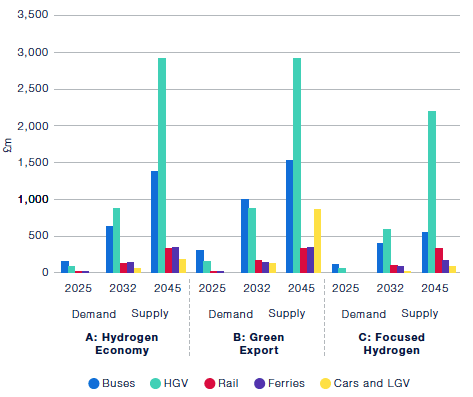
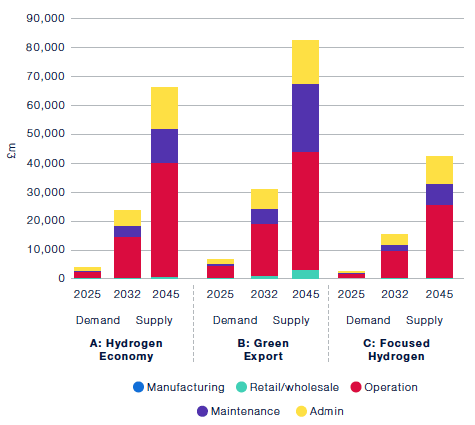
| Sub-sector | Source of Value | Additionality | Skills & Location |
|---|---|---|---|
| Buses Jobs in 2045 A: 19,600 B: 21,900 C: 7,700 |
Manufacturing Bus assembly and system integration. Maintenance Maintaining the bus fleet. Transport services Provision of services though operation of the bus fleet. |
Generally not additive since hydrogen buses replace existing vehicles and services. Manufacturing, for example at Alexander Dennis Limited (ADL), could be additional. |
O&M widely distributed with all towns/cities operating bus fleets. Manufacturing is assumed concentrated in Falkirk where ADL has its manufacturing facility. |
| HGV Jobs in 2045 A: 36,500 B: 36,500 C: 27,400 |
Maintenance Maintaining the HGV fleet. Transport services Provision of services through the operation of the HGV fleet. |
Generally not additive since hydrogen trucks replace existing vehicles and services. | Jobs and value added are expected to be centred around existing depots and refuelling locations, e.g. Clydeports. |
| Passenger cars and LGVs Jobs in 2045 A: 3,400 B: 17,000 C: 1,600 | Retail Sale of passenger cars and LGVs. Maintenance Maintaining passenger cars and LGVs. |
Generally not additive since hydrogen passenger cars and LGVs replace existing vehicles and services. | Dealership and maintenance activities are widely distributed. |
| Trains Jobs in 2045 A: 4,300 B: 4,300 C: 4,300 |
Maintenance Maintaining hydrogen trains. Transport services Provision of services through operation of hydrogen trains. |
Generally not additive since hydrogen trains replace existing vehicles and services. | Jobs and value added are expected to be centred around existing depots and refuelling locations. |
| Water transport Jobs in 2045 A: 2,400 B: 2,400 C: 1,200 |
Maintenance Maintaining hydrogen vessels. Transport services Provision of transport services through operation of hydrogen vessels. |
Generally not additive since hydrogen vessels replace existing vessels and services. | Operation of ferries is concentrated on the west coast, and Western and Northern Isles. |
Bus manufacture could represent a significant opportunity for Scotland
Vehicle manufacturing and assembly are considered relatively high value added activities and are often associated with deep supply chains. Scotland has existing capabilities in bus and ferry manufacture and a limited supply chain surrounds these activities in Scotland. It is thought that an opportunity may exist to extend this capability into hydrogen/fuel cell alternatives although there is limited track record to date. The analysis only considers the manufacture of buses at the existing ADL plant in Falkirk for domestic deployment whereas scope exists to expand this activity if export opportunities present themselves, whether to the rest of the UK or overseas.
While the local market in Scotland is probably not large enough to make it attractive enough for a vehicle original equipment manufacturer (OEM) to locate a fuel cell car assembly plant it may be worth considering whether to support an opportunity in more specialised vehicles. If an extended hydrogen vehicle supply chain emerges around ADL this may support such an initiative, with potentially common supply chain elements. It should be emphasised that an established local extended component supply chain is lacking today.
Scotland has existing capabilities in the operation and maintenance of all vehicle/vessel types and it is anticipated that these could be redeployed to hydrogen/fuel cell alternatives. Indeed some of this expertise already exists based on the participation of Aberdeen in fuel cell bus trials.
Emerging opportunity in hydrogen marine
The analysis only considers the value of operating hydrogen domestic ferries and other water transport however there are potentially some opportunities in the wider fleet, e.g. offshore service vessels. The Scottish marine sector have been involved in designing a prototype hydrogen vessel as part of the HySeasIII project[21] which could evolve into a value generating activity. Recent evidence of Scottish shipbuilding being able to compete in international markets is limited and recent troubles with the ferry programme give cause for concern. However, the emergence of a hydrogen ferry manufacturer may present an interesting opportunity for Scotland and further investigation of this would be warranted.
Key skills and supply chain present in Scotland
While Scotland generally has a limited supply chain in the design and construction of vehicles and vessels, it has made some early movements into hydrogen transportation including:
- Scotland has led the development of hydrogen fuel cell projects with the Aberdeen Hydrogen Bus project operating 10 hydrogen powered buses. Through this project Aberdeen City Council have become involved in the pan-European JIVE Scottish bus manufacturer ADL has also become involved in JIVE and subsequently launched their first hydrogen powered double decker bus in 2019.
- In marine transportation, the Scottish Marine sector are involved in developing one of the world’s first hydrogen ferries in collaboration with St Andrew’s University and Orkney Island Council as part of the HySeas III project.
- Brodie Engineering, a train refurbishment firm in Kilmarnock, has been contracted to convert a ScotRail train to hydrogen power using technology developed by St Andrew’s University and London based Arcola. The converted train will be tested in Scotland and is part of Transport Scotland’s work exploring alternatives to diesel fuel.
Heat, industry and power: An important driver of demand
Value added from the domestic and commercial hydrogen heat sector is expected to be modest at £177 m in 2045, although the number of people employed in the sector may be quite sizable reaching nearly 4,000 jobs in 2045 (Figure 48). This apparent discrepancy reflects the fact that these jobs come from maintaining a very large number of domestic boilers. No boiler manufacturing activities are expected. However, the heat and industry sectors could be an important driver of demand and underpin the roll-out of production capacity. The contribution from industry and power generation is also modest, reaching a maximum of £263 m in 2045 in Hydrogen Economy. Similarly, job creation is modest reflecting the economies of scale realisable at large facilities with around 1500 jobs created.
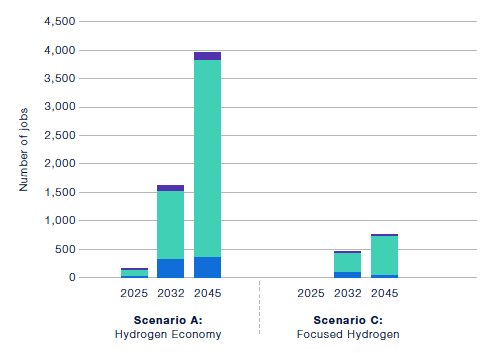
| Sub-sector | Source of Value | Additionality | Skills & Location |
|---|---|---|---|
| Domestic and commercial heat Jobs in 2045 A: 4,000 C: 800 |
Installation and especially maintenance of boilers. Note no hydrogen is used in this sector in Green Export. | O&M of equipment is not additional but would lead to job and value retention. New equipment installation may be additional if installation is quicker than usual replacement cycle. |
In Hydrogen Economy, highly distributed activity but concentrated in areas where the penetration of gas grid most extensive. Concentrated deployment in Focused Hydrogen. |
| Industrial heat Jobs in 2045 A: 1,500 B: 800 C: 400 |
Maintenance Maintaining industrial boilers. |
The replacement of equipment may provide some additional value but activity is largely replacement / retention. | GVA and jobs likely to be centred around existing industrial sites on the east coast, e.g. Grangemouth. |
| Power generation Jobs in 2045 A: 100 B: 100 C: 100 |
Operation of hydrogen-fuelled generating plant - relatively sizable in Focused Hydrogen, given low overall usage, but limited in Hydrogen Economy and Green Export. May be some value added from the refitting of plants but this has not formed part of the analysis. |
Likely to be replacement / retention as hydrogen replaces natural gas. | Locations around existing gas- or diesel-generating plants, e.g. on the islands and some onshore locations such as Peterhead. |
Opportunity in fuel cells for power and heat
Scotland has an opportunity to build on existing skills in higher value added activities such as the design and production of stationary fuel cell for power and heat applications and leverage it into the heat sector. Outside systems integrators such as Logan Energy, Scotland's capabilities are currently limited and consideration should be given as to whether support mechanisms for technology developers could be used to further this sector. However, it should be emphasised that well established and well capitalised players in this domain may limit the potential for Scottish players to emerge. Scotland does possess extensive skills in heat and power generation system installation, operation and maintenance which could likely be repurposed to hydrogen based systems, retaining value and jobs in Scotland.
Key skills and supply chain present in Scotland
There is a relatively limited indigenous supply chain of OEMs supplying key equipment for heating applications. However, the existing gas supply chain has transferrable skills and some highlights in terms of Scottish experience include:
- Doosan Babcock, an international engineering company with an office in Renfrew installed the UK’s largest hydrogen fuel cell system at the Aberdeen Exhibition and Conference Centre (AECC) which provides heat and power for the venue.
- SGNs H100 project will lead to the development of local supply chains for the installation and maintenance of domestic hydrogen equipment.
- Enocell, based in Lanarkshire, specialise in fuel cells that are designed to provide power generation in rural communities that have limited access to grid power. The company was founded in 2011 as a spin out from the University of Aberdeen.
- There are a number of SMEs in Scotland that can provide subcomponents for fuel cell manufactures, for example Ceimig, based in Dundee, specialise in precious metals and manufacture fuel cell catalysts.
- Logan Energy has capabilities in stationary fuel cell integration and deployment with installations around the UK including the Palestra building in London. They also carried out the integration work on the Levenmouth Community Energy.
Contact
Email: onshoreoilandgas@gov.scot
There is a problem
Thanks for your feedback